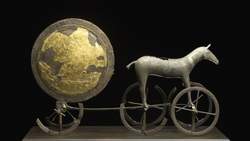Nuove foto aggiunte
5 marzo 2015
Signs & Symbols of the Sun
According to Copernicus in "De revolutionibus orbis", Hermes Trismegistus called the sun a visible god - the alchemists equated the sun with gold, the purest of metals, which represented the perfection of all matter, material and spiritual. The sun has been an important object of worship throughout the ages and in various cultures. We will be offering you images based on "Signs & Symbols of the Sun" by Elizabeth S. Helfman, New York: The Seabury Press, 1974, a book which presents images of the sun from the Sumerians and the Egyptians to the Indians and Inuit.
"In many parts of the world people believed that the sun god made his daily journey in a golden chariot which in many instances was pulled by white horses and they, too, became symbols of the sun. We have already seen that this was true of the Sumerians, Persians, the Greeks, and the Romans. Much of the same beliefs were held by the Scandinavians who lived in northern Europe. The people of this region have always had a special feeling for the sun. In much of the area where they live, winter lasts for more than half a year and the nights are very long. The sun is welcomed with joy and thanksgiving each day as it breaks through the winter dark. There are rock carvings that show ships and chariots carrying sun disks. A beautiful relic of early times was found in a bog in Denmark. It is a small chariot of the sun, made of bronze and gold, dating back to one thousand years or more before the time of Christ. Six wheels, only one of them intact, hold up a framework that carries a sun disk engraved on both sides with circles and spirals. Gold plating still remains on one side of the bronze disk. In front of the disk stands a charming horse, with rays radiating from his eyes, as if they, too were symbols of the sun."
www.ritmanlibrary.com
#sun #chariot #Scandinavia
Download the guide of The Ritman Library for free!
http://bit.ly/HermeticallyOpen
According to Copernicus in "De revolutionibus orbis", Hermes Trismegistus called the sun a visible god - the alchemists equated the sun with gold, the purest of metals, which represented the perfection of all matter, material and spiritual. The sun has been an important object of worship throughout the ages and in various cultures. We will be offering you images based on "Signs & Symbols of the Sun" by Elizabeth S. Helfman, New York: The Seabury Press, 1974, a book which presents images of the sun from the Sumerians and the Egyptians to the Indians and Inuit.
"In many parts of the world people believed that the sun god made his daily journey in a golden chariot which in many instances was pulled by white horses and they, too, became symbols of the sun. We have already seen that this was true of the Sumerians, Persians, the Greeks, and the Romans. Much of the same beliefs were held by the Scandinavians who lived in northern Europe. The people of this region have always had a special feeling for the sun. In much of the area where they live, winter lasts for more than half a year and the nights are very long. The sun is welcomed with joy and thanksgiving each day as it breaks through the winter dark. There are rock carvings that show ships and chariots carrying sun disks. A beautiful relic of early times was found in a bog in Denmark. It is a small chariot of the sun, made of bronze and gold, dating back to one thousand years or more before the time of Christ. Six wheels, only one of them intact, hold up a framework that carries a sun disk engraved on both sides with circles and spirals. Gold plating still remains on one side of the bronze disk. In front of the disk stands a charming horse, with rays radiating from his eyes, as if they, too were symbols of the sun."
www.ritmanlibrary.com
#sun #chariot #Scandinavia
Download the guide of The Ritman Library for free!
http://bit.ly/HermeticallyOpen

